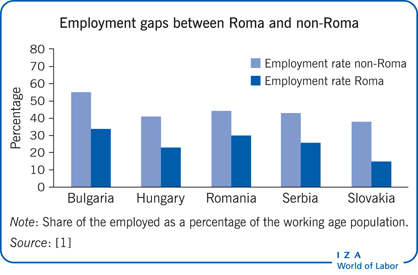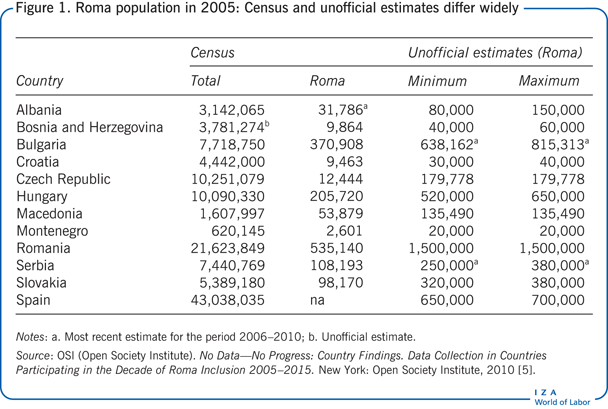Elevator pitch
The Roma are the largest ethnic minority in Europe—as well as one of the most disadvantaged. A triple vicious circle is at play: Substandard socio-economic outcomes reinforce each other; they fuel negative attitudes and perceptions, leading to ill-chosen policies; and segmentation is perpetuated through (statistical) discrimination. A severe lack of data precludes progress. However, existing bits of evidence point to virtuous ways out.
Key findings
Pros
A severe segmentation of Roma and non-Roma populations is documented in both human capital and labor market outcomes.
Residential segregation results in gaps in educational attainment, which is a key factor behind these labor market disparities.
Socio-economic gaps are perpetuated through the link between parents’ education and household resources and the educational achievement of children.
Awareness of the severity of the Roma’s situation, of the lack of reliable data, and of the inadequacy of integration policies is increasing.
There are policy options that can facilitate the social and economic integration of Roma.
Cons
The lack of data and multiple measurement biases make measuring Roma populations and their socio-economic conditions almost impossible.
Roma are a highly heterogeneous population in their level of integration and labor market position, making generalizations problematic.
Closing the human capital gap between Roma and non-Roma may not be sufficient to provide equal chances in the labor market, as differentials in returns to human capital, signalling unequal treatment, appear to be the norm.
Political elites lack the will and courage to address Roma integration challenges.
Author's main message
Labor market integration of the Roma is a moral and economic imperative. The pathology of social and economic separation and mistrust affects both Roma and non-Roma populations. Thus, policy intervention must target whole communities, and its scale and scope must be commensurate with the challenge: preventing the residential and social segregation that engenders multiple inequalities, addressing the intergenerational transmission of poverty and the human capital disadvantages of children and their parents, and ensuring equal treatment in the labor market. Political courage and will are wanted.
Motivation
The Roma people—concentrated mainly in central and eastern Europe, but also in Spain—are one of Europe’s largest, poorest, and most socially excluded ethnic minorities [2], [3]. Against an average EU employment rate of 69% for people aged 20–64 in 2010, the rates for the Roma were just 19% in Spain, 29% in Slovakia, and 32% in Romania [4]. Since labor market integration is a prerequisite for broader social integration, these gaps underscore one of the direst integration policy challenges in Europe.
This article maps what hard evidence there is about the labor market situation of the Roma in Europe, its determinants, and the available policy options. It seeks to inform the debate about what integration policies can be efficient and effective. This is a much-needed effort, since data and measurement problems have made robust evidence difficult to obtain. The focus of this article is on economic integration and not on the cultural aspects of integration.
Discussion of pros and cons
What we know about the Roma population
Researching Roma economic integration is complicated by a severe lack of data. Missing data relate not only to several general issues such as small sample sizes of Roma in nationally representative data sets, missing observations, missing variables, and a lack of longitudinal data. Research is also complicated by the specific problem of the lack of self-identification of Roma people in survey data. This issue is particularly problematic, as it often precludes even general statistics about Roma populations based on census or survey data. Ascribing ethnicity in survey or administrative data is generally illegal and not free of bias.
Due to the lack of good-quality data, research about the Roma has been conducted mainly by government and civil society organizations. Only a small number of studies have originated from academic research projects, and only a fraction of these have been published in international peer-reviewed journals. Despite these data limitations, there is a small body of research that sheds some light on the labor market situation of Roma populations.
Roma populations are present across Europe and in diasporas around the world, with the majority of Roma living in central and south-eastern Europe [3]. Problematic identification of the Roma in most census or survey data makes it difficult to provide precise figures. Official census data differ markedly from unofficial estimates in countries with large Roma populations (see Figure 1). The main message from this wide discrepancy is twofold. First, the message is not mainly about the precise size of Roma populations, but rather about the severe lack of data on these populations. Second, despite these data limitations, we can reasonably conclude that several European countries have significant Roma populations.
It is even more difficult to depict the Roma’s labor market situation, as different sources provide different statistics. These differences are partly explained by different definitions of the employment rate (for example, how employment is measured) or the target population (age cohort or definition of Roma). Further biases arise due to the marginalization of Roma in the labor market, mainly in relation to their considerably higher incidence of precarious or informal employment [1].
Data from the 2011 United Nations Development Programme (UNDP), World Bank, and European Commission regional Roma survey can help us better understand the nature of labor market gaps between Roma and non-Roma populations [1]. The survey provides comparable data representative of vulnerable Roma and non-Roma living in their proximity for a number of countries. Figure 2 provides a general overview indicating very large gaps in employment rates between Roma and non-Roma. Specifically, there are considerably lower labor market participation rates among Roma than non-Roma in most countries, with the exception of Albania (both men and women) and Hungary, Montenegro, and Macedonia (men only). Employment rates mirror this picture, with markedly lower employment rates among vulnerable Roma than among non-Roma living in proximity to Roma. In Croatia, the Czech Republic, Moldova, and Slovakia, labor market gaps between Roma and non-Roma populations exceed 20 percentage points for men. For women, only Albania (6 percentage points), Romania (15), Macedonia (16), and Serbia (18) report employment gaps below 20 percentage points; in Croatia the gap is more than 30 percentage points, and in the Czech Republic it exceeds 40 points.
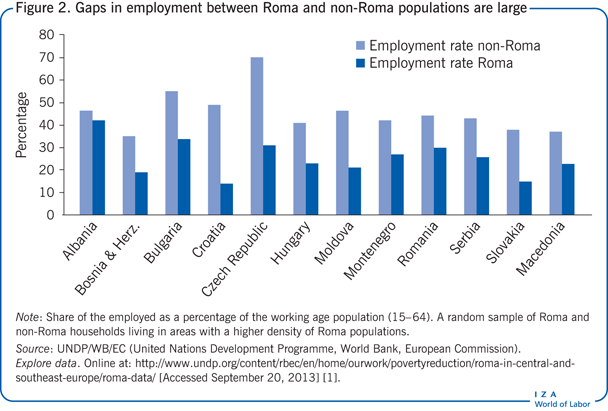
Roma women appear to face a double disadvantage in securing employment. Whereas the unweighted average difference in Roma/non-Roma participation rates across the 12 countries is 7.5 percentage points for men, it is twice as high for women (see Figure 3). For employment, the disadvantage of Roma women compared with non-Roma women is 22.9 percentage points, while the corresponding figure for men is 17.2 percentage points.
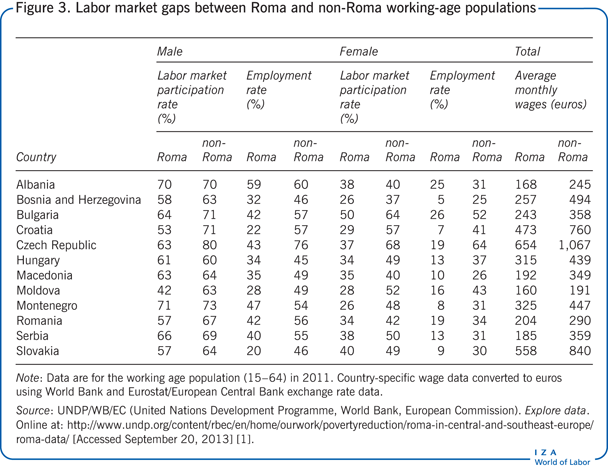
Roma workers face additional disadvantages in pay. Their earnings from employment are markedly lower than those of their non-Roma counterparts, especially in Serbia, Bosnia and Herzegovina, and Macedonia. In addition, comparatively high informality rates in work status among Roma indicate that their employment status is far more fragile than that of the non-Roma [1].
Causes of labor market segmentation
Few studies have examined the causes of labor market gaps between Roma and non-Roma populations. Some of the key factors hypothesized to explain the gaps are related to discrimination or differences in human capital. Expert stakeholders (mainly civil society organizations) in the IZA Expert Opinion Survey identify discrimination as the greatest barrier to social and labor market integration [2]. A number of other studies also indicate a high degree of perceived discrimination in access to the labor market or health care [4].
Gaps in education and health status and differences in returns to characteristics
Gaps in education and perceived health are considerable (see Figure 4). One robust finding is that the average years of education of vulnerable Roma are substantially lower than those of non-Roma living in proximity to them. The gap is generally larger for women than for men, underscoring the additional disadvantage of Roma women in access to education. While the Roma self-report a bad health status more often than non-Roma in a majority of countries, the gaps are generally smaller than for education. However, gaps in access to health care or health insurance are generally larger and disfavor Roma populations [1].
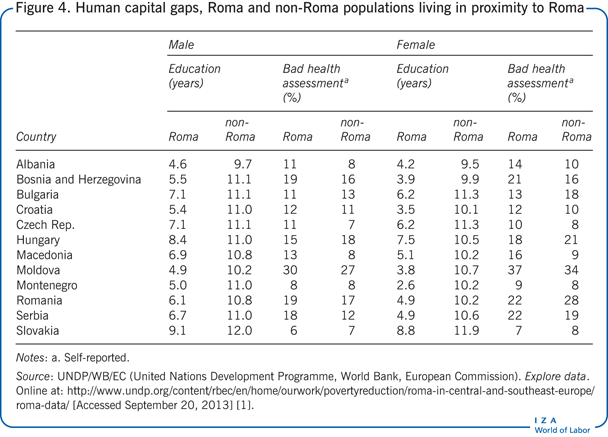
Do such gaps in human capital explain Roma/non-Roma differences in labor market outcomes? One recent investigation of the nexus between human capital and the labor market used 2004 UNDP data on vulnerable Roma in southeastern Europe [4]—including Albania, Bosnia and Herzegovina, Bulgaria, Croatia, Kosovo, Macedonia, Montenegro, and Serbia (excluding Kosovo)—to disentangle the causes of labor market gaps between vulnerable Roma and non-Roma living in proximity to them [6]. The returns to years of schooling in terms of employability are significantly higher for non-Roma than for Roma workers. This result becomes even stronger after accounting for the endogeneity of educational attainment—that is, the possibility that the relationship between educational attainment and employment is driven by the decision to stay in school longer (motivated by an expectation of improved employment prospects) rather than by an enabling role of education in securing employment.
This study further finds that a large part of the employment gap cannot be explained by differences in characteristics of Roma and non-Roma (such as differences in educational attainment) and is rather due to differences in returns to characteristics (such as different pay premiums for a university degree) or unobserved factors, which may include gaps in ethnic or social capital as well as discrimination.
Further support for these findings is found in the analysis of a data set of four Hungarian surveys conducted between 1993 and 2007 [7]. The analysis shows that gaps in educational attainment are a primary explanatory factor for the gaps between Roma and non-Roma employment rates, whereas the geographic distribution of Roma and non-Roma populations does not play much of a role after controlling for differences in education. In addition, the number of children in the household is important for female employment. Educational attainment and number of children in the household, while important, do not account for the entire employment differential, however; a considerable part remains unexplained by individual characteristics.
Several studies have examined wage differentials as a proxy for disparities in job quality or occupational segmentation. One study found that the returns to education (in terms of earnings) are similar for Roma and non-Roma populations, even after accounting for shortcomings in the data (the sample included only people willing to report their income and working in the formal economy as employees) and for the endogeneity of schooling [6].
Another study, which also used the UNDP 2004 data set for Albania, Bulgaria, Croatia, Kosovo, and Serbia [4], attempted to disentangle the causes of labor market gaps between vulnerable Roma and non-Roma living in proximity to them [8]. That study showed that major parts of the observed income gaps were due to differences in human capital characteristics, including education and work experience. Additional gaps were due to the sorting of Roma and non-Roma into full-time or high-skilled jobs. In fact, in all countries except Albania and Kosovo the part of the pay gaps that remained unexplained after controlling for these differences was not significantly different from zero.
Yet another study, which identified a significant wage gap between Roma and non-Roma women in the Athenian labor market, argued that only a relatively small part of the wage differential could be explained by a broad set of observable characteristics. The larger part of the gap was attributable to differing returns to characteristics (for example, differing pay premiums for different university degrees), differences in social or ethnic capital, or other unobservable factors such as discrimination. The study also showed that sorting across occupations and sectors did not affect this result significantly [9]. The study based on the four Hungarian surveys between 1993 and 2007 confirms these results: Differences in characteristics can explain only about half of the wage gap between employed Roma and non-Roma populations (not accounting for differences in selection into employment) [7].
An important factor possibly affecting the estimated gaps between Roma and non-Roma in wages or employment quality is (self-)selection into labor market participation or employment. If Roma face barriers to labor market participation or employment, it is likely that the Roma who succeed in overcoming the barriers possess some labor market skills that are superior to those of their non-Roma counterparts, who do not need to cope with such barriers. If, due to data limitations, this difference in skills between participating or employed Roma and non-Roma cannot be accounted for in statistical analysis, comparing observably similar Roma and non-Roma populations underestimates the true gaps. This is because the true gaps between Roma and non-Roma with the same characteristics, observed and unobserved, are partly offset by the extra, unobserved skills that the successful Roma possess.
Policy implications
The studies reviewed here have important implications for policy. The results indicate that the Roma/non-Roma gaps are, to a large extent, due to socio-economic segmentation even before Roma and non-Roma workers enter the labor market. Additionally, closing the education gap between Roma and non-Roma may not be sufficient to provide equal chances in the labor market, as differentials in returns appear to be the norm. These findings also indicate that labor market gaps between Roma and non-Roma populations are due both to differences in social class—the vulnerable, marginalized status of the Roma populations as manifested by, for example, Roma’s lower educational attainment—and to disparities in ethnic or social capital, or discrimination. Certainly, however, marginalization may itself be related to these disparities in a non-trivial way.
If the gap in educational attainment is a particularly important factor in explaining the differences in labor market outcomes for Roma and non-Roma populations, it will be instructive to shed light on its cause. While one study has shown that the differences in factors affecting the educational attainment of Roma and non-Roma do not differ much, one notable exception is the educational disadvantages of Roma who live in areas of high Roma concentration. Residential segregation thus appears to be one of the key determinants of Roma/non-Roma educational gaps. But it could also be the case that educated Roma leave these areas. Another structural difference identified in the analysis is that whereas both Roma and non-Roma populations living in urban areas have higher educational attainments than those living in rural areas, this effect of urbanization is much smaller for the Roma. This difference is probably a result of the large concentrations of Roma among low-educated population groups in urban and rural areas alike [6].
Intergenerational transfer of human capital is another important mechanism through which Roma/non-Roma gaps in human capital are perpetuated. In Bosnia and Herzegovina, Croatia, Montenegro, and Serbia, the educational attainment of household heads is strongly linked to the educational attainment of children, an effect that is especially powerful among the Roma [10]. Differences in achievement between Roma and non-Roma eighth graders on standardized tests in reading and math are explained largely by health, parenting, family background, and segmentation across schools and classes [7].
Synthesizing this evidence, it appears that multiple vicious circles are at play. Substandard socio-economic outcomes of the Roma reinforce each other and are perpetuated through the intergenerational transfer of human capital. These factors also engender negative attitudes and inhibit trust between Roma and non-Roma, which breeds ill-chosen integration policies and leads to (statistical) discrimination. This, in turn, further propagates socio-economic segmentation. In this adverse environment, the Roma may face tension—or even trade-offs—between their ethnic and cultural capital on the one hand and socio-economic integration on the other. Roma women are exposed to yet another tier of barriers, probably stemming from gender stereotypes and social norms within Roma communities.
Integration policy options
An edited volume drawing on the IZA Expert Opinion Survey of minority representatives and case studies concludes that the integration of ethnic minorities is a legitimate policy objective, strongly desired by ethnic minorities in the European Union [2]. The authors review a broad range of integration initiatives that have led to greater labor market integration of Roma. They find that successful initiatives are effectively implemented, feasible, positively perceived by both minority and majority populations, and treat involved parties fairly and according to transparent rules. Participation needs to be voluntary, and, if selection criteria are applied, they should be strict and transparent. Interventions need to be targeted, but participatory and non-segregating. Such conduct facilitates trust, social relationships, and positive perceptions of the initiative by all the parties involved. Long-term commitment and cooperation among state, private, and civil society organizations are key to success. Finally, complementarities between integration policies and labor market policies and institutions, migration policies, and the welfare state need to be accounted for.
Limitations and gaps
Data insufficiencies and the socio-economic segmentation of Roma and non-Roma populations make measuring even the basic characteristics of Roma populations problematic, let alone analyzing or drawing statistical inferences about the factors of Roma labor market integration. For example, that there are only small numbers of highly-educated Roma in the data sets can dramatically skew the estimated returns to education for the group as a whole. Controlling for these as outliers helps little, as the estimated effects then reflect returns to education only at the bottom of the educational distribution [7].
Additional challenges posed by insufficient data include the endogeneity of schooling and other explanatory variables, as well as (self-)selection into labor market participation or employment. As these limitations could bias statistical inference and thus misguide policies, it is important that researchers and policymakers understand them well and work together to overcome them, starting with gathering better data.
Summary and policy advice
The segmentation of Europe’s labor markets along Roma and non-Roma ethnic lines results in poverty, social exclusion, and lower labor market status for the Roma. This in turn undermines the economic potential of some of Europe’s poorest regions, where the Roma are concentrated.
Educational inequality is a key factor behind labor market gaps between Roma and non-Roma populations. Thus, an important policy objective is to prevent the residential and social segregation that engenders educational and other inequalities. Intergenerational transfers of human capital imply that comprehensive policies need to address the poverty and educational disadvantages not only of children but also their parents.
Narrowing, or even eliminating, human capital gaps is not sufficient, however. Equal treatment in the labor market needs to be ensured—and this will involve nurturing trust between Roma and non-Roma populations.
Several initiatives demonstrate that this is possible. Good practices have to be identified with robust evidence and brought up to the scale and scope commensurate with the challenges.
Acknowledgments
The author thanks an anonymous referee and the IZA World of Labor editors for many helpful suggestions on earlier drafts.
Competing interests
The IZA World of Labor project is committed to the IZA Guiding Principles of Research Integrity. The author declares to have observed these principles.
© Martin Kahanec
Roma
United Nations Development Programme (UNDP) 2004 and UNDP, World Bank, and European Commission 2011 data sets
UNDP/FRA (United Nations Development Programme, European Union Agency for Fundamental Rights). 2012. The Situation of Roma in 11 EU Member States: Survey Results at a Glance. New York: UNDP, and Vienna: FRA.
UNDP/WB/EC (United Nations Development Programme, World Bank, European Commission). Explore data. View Online [Accessed September 20, 2013].
